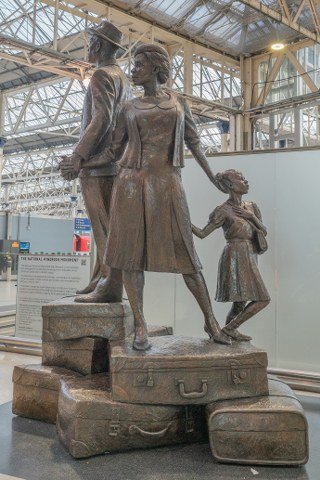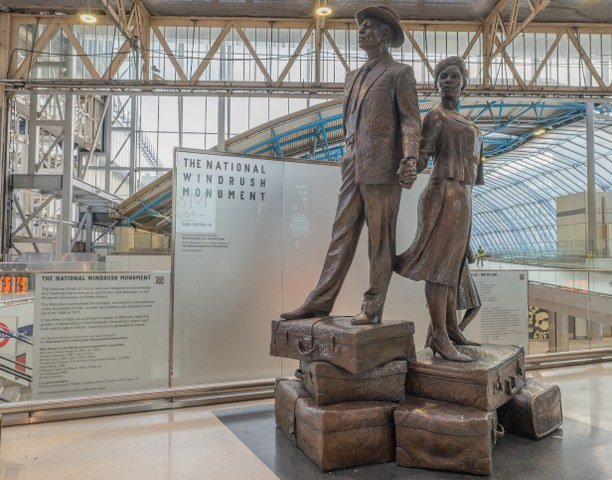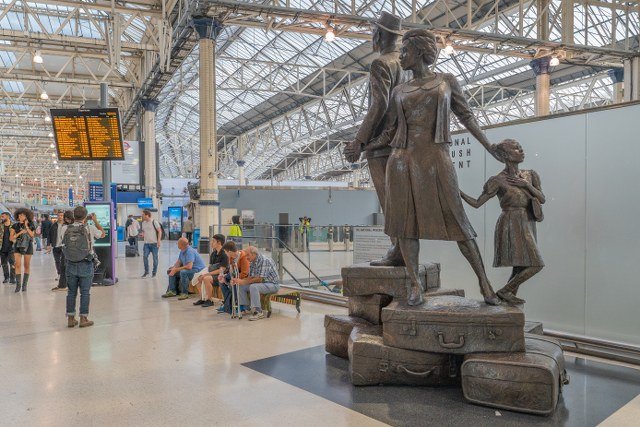10 FREE things to see near London Eye in less than 1 hour ( self-guided walking tour with a map)
Text & photography by Anna Kmiecik, private tour guide in London.
Distance to cover: 2.6 miles (4 km)
If you click on the map, a new window will open for live navigation in the field.
London Eye is one of the most popular tourist attractions in London.
Did you ever wonder what else is there to see near London Eye?
I have prepared for you a free and self-guided walk around the hidden gems of Waterloo.
10 things to see and all of them are located only steps away from London Eye.
I hope you will enjoy this walk.
London Eye was built in 1999 to provide the entertainment initially only for 5 years. It was part of celebration of the beginning of new millennium. However, this plan was changed after it turn out how popular this attraction is with public.
10 things to see near London Eye
1. Wall of Love
I recommend you start this walk by seeing the long wall stretching along the River Thames, covered with hand-painted red hearts, called The National Covid Memorial.
Over 150,000 hearts are painted on this wall, each of them symbolizing a different person who lost life during the pandemic.
This monument was built originally without the official permission of the city authorities.
It was a social, spontaneous initiative that, you could say, got out of hand.
People simply started to come to this place and draw hearts, writing on them the names of their loved ones that they lost during the pandemic.
The city, out of respect for the victims of the pandemic and their families, decided not to treat it as "vandalism" and turned this wall into an official monument.
This 'Wall of Love' is right by the steps to Westminster Bridge, 2 mins walk from the London Eye in a very symbolic location - next to the Florence Nightingale Museum* and St. Thomas Hospital.
*Florence Nightingale was a social reformer. All her life she was working to improve health care for ALL members of British society. It is here at St. Thomas Hospital she founded in 1860 the world's first nursing school.
2. Leake Street Tunnel (Banksy Tunnel)











The longest LEGAL graffiti wall in London you can find at Leake Street, near Waterloo Station.
One of the best places in London to see street art. 300m long workshop and a gallery at the same time.
Free for everyone to create graffiti or to see one.
It all began in 2008 when enigmatic street artist Banksy hosted his CANS FESTIVAL there.
After that, the place became a mecca for graffiti artists. People come from around the world to perform their craft there.
The great and at the same time a bit sad fact about this place is that even the most spectacular of graffiti are not staying there for long.
The walls are changing there almost daily. You can often witness the whole process of creation as well.
Interesting place, even if you are not a graffiti fan.
3. Waterloo Cemetery Station
On Westminster Bridge Road, at number 121, you can see the remains of a unique Railway Station.
Between 1902-1941 this station was used for transporting mainly…
…dead bodies.
Trains departing from here were transporting only coffins with the bodies of the deceased and their families for the funerals at the Brookwood Cemetery, located approximately 40 kilometers from London.
The so-called London Necropolis Railway had been in operation since 1854.
Around this time cemeteries in London stopped coping with the demand.
In 1851, after the cholera epidemic in London, the city authorities, for hygiene reasons, prohibited further burials in built-up areas in London, fearing contamination of drinking water. Hence the creation of the London Necropolis Railway.
The very first Cemetery Station was located near Leak Streat, but it was demolished during the expansion of Waterloo Station in the late 19th century.
A new station was built right here on Westminster Bridge Road, and the railway arches of Waterloo Station served as morgues during the lifetime of this "funeral" line.
There were two types of tickets at Waterloo Cemetery Station: tickets for living persons and for dead ones.
Alive customers could only purchase return tickets (the one-way ticket option for them did not exist at all) at prices comparable today to £30, £17, and £10 (they were three ticket classes: first, second or third).
Tickets for the coffins (of course one way only!) were considerably more expensive - £ 100, £ 25 and £ 12 depending, also on the class.
Their prices depended on the type of burial and the chosen place in the cemetery.
It is worth mentioning that the prices of these tickets have not changed for over 80 years of this line's existence (!)
The Cemetery Station was bombarded by Luftwaffe during the Second World War and, as a result, was heavily damaged.
Rebuilding this station wasn't reasonable (cost-wise) and thus Waterloo Cemetery Station became a thing of the past.
The surviving part of this station, still visible today on Westminster Bridge Road, was sold and converted into offices.
Today you can see the entrance gate for customers with first-class tickets, and above it, the former offices of the company that used to run this station.
4. The birthplace of CIRCUS and 200-year-old street
Next point on my map will take you to the location, where the idea of the modern Circus was born. And put into practice for the very first time.
Entertaining people with tricks performed by domesticated animals in the open-air (back then) performed there 250 years ago is celebrated today with a blue plaque opposite no22 of Cornwall Rd.
And by taking a few steps towards Roupell Street, you can quickly get yourself into the spirit of the 19th century.
Your time machine will be over 70 residential buildings from the Georgian times, which managed (by some miracle) to survive untouched for around 200 years!
This street is a popular destination for movie crews (Doctor Who, Mr. Selfridge or James Bond, just to mention a few).
5. Charlie Chaplin and Cinema “at the roundabout"
Odeon BFI IMAX cinema at Waterloo. Photography: Zuzanna/WalkMeBlog
One of the most famous people in the history of film industry, Charlie Chaplin, spent the beginning of his life living in Waterloo.
However, it wasn't a happy time.
His childhood was marked by suffering and poverty.
Not much within the area survived from that period and Charlie Chaplin is not somehow spectacularly celebrated here (its history is long and extremely complicated), but at the roundabout by the Waterloo Bridge you can see the largest cinema screen in Great Britain (20m x 26m), and the address of this cinema is 1 Charlie Chaplin Walk!
Useful info: near London Eye, on clear days, you can sometimes meet a street artist (mime) dressed as Charlie Chaplin and in Leicester Square, you can see a statue dedicated to this silent film legend.
See also: Movie statues in Leicester Square
6. Benches made... not for sitting
In the part of Waterloo called Southbank, located just by the river, you can find a lot of interesting sculptures and a few artistic benches.
However, it is not possible to rest on all of them.
I like the most the ones called Modified Social Benches.
What are they?
They are red benches with unexpected (for benches!) shapes.
That (obviously) makes them very popular with the youngest tourists.
There are several of them there, so I recommend you take a long walk around Southbank to see them all.
7. Skateboard “graveyard” at Jubilee Bridge
Next point on my map has a grim story to tell.
In 1999, a 24-year-old skater Timothy Baxter and his friend Gabriel Cornish when walking along walkways of Hungerford Bridge, became random and very unfortunate victims of robbery by a group of teenagers.
Timothy and Gabriel were without luck, as they did not carry many belongings.
Skating board and rucksack, that's it. Not much to give to the thefts, looking for quick money for alcohol and drugs.
Skaters at Southbank Skatepark (2022). Photography: Zuzanna/WalkMeBlog
As a result, they were beaten and thrown into the Thames by the troubled group.
Timothy did not survive.
Around eight years after this dreadful murder, broken skateboards started appearing on one of the bases supporting footbridges, belonging to skaters using located nearby Southbank Skatepark.
The Skateboard Graveyard (as it's called now) does not have any official status or a plaque in place.
In fact, the bridge cleaning team often removes the broken skateboards from there. But they always do reappear.
An original way to pay a tribute. I think.
8. Open-Air Book Market under the bridge
Southbank Book Market it is an open-air, second-hand and antique book market, located just under Waterloo Bridge.
You can find great books when getting the breeze of fresh air.
You can find more details about this place on this website.
And if you don’t want to bother to carry a book with you, you can always read some poetry from paving tiles outside Southbank Centre!
If you think that paving tiles are boring, think again. Southbank (2021). Photography: Zuzanna/WalkMeBlog
9. “The Ladies Bridge”
Waterloo is named after the nearby Waterloo Bridge.
The first version of the Waterloo Bridge in London was put in place in 1817, shortly after the British (and their allies) won the Battle of Waterloo* in 1815. The name of this bridge was to commemorate this very important event.
* Napoleon's last (lost) battle that sealed his fate.
In the 1930s, the old Waterloo Bridge was in such bad shape that needed to be demolished.
The Great Depression (financial crisis) delayed the construction of a new bridge in this place. Its construction took place a bit later, during the Second World War.
With men being sent to war, women were the only available labor.
Over 350 women participated in building the bridge under the fire of the Luftwaffe*. This is why Waterloo Bridge is called sometimes "The Ladies Bridge".
* The Waterloo Bridge was the only bridge in London damaged by bombings during the Second World War.
It is also worth mentioning that the designer of the Waterloo Bridge was the same architect who designed the famous British telephone box, Giles Gilbert Scott.
Interesting link: click on this website link to see photos of women (welders) working on the construction of the Waterloo Bridge during the Second World War.
10. National Windrush Monument at Waterloo Station
I recommend you finish this walk at Waterloo station, where you can see the National Windrush Monument.
This sculpture shows an elegantly dressed family (parents with a daughter) standing on a podium made of suitcases.
It is a memorial to the contribution of the Caribbean people to the rebuilding of London after the Second World War.
It was here, at Waterloo Station, that they took their first steps upon arrival to the UK.
This statue is by Jamaican sculptor Basil Watson.
You can find this sculpture inside Waterloo Station, near the entrance to the tube (you don't need to buy a ticket to see it).
The statue was unveiled by Prince William in June 2022.
Looking for a unique and memorable souvenir from London?
Turn your favourite London moment into a tiny enamel pin to wear and remember!
You can customise a Waterloo landmark, a bit of street art, or even a photo you took on your trip (and add some text if you like!).
Custom enamel pins make great travel souvenirs for you and your loved ones. Check it out!
Click on the picture below to see more details.
Did you enjoy his post?





































